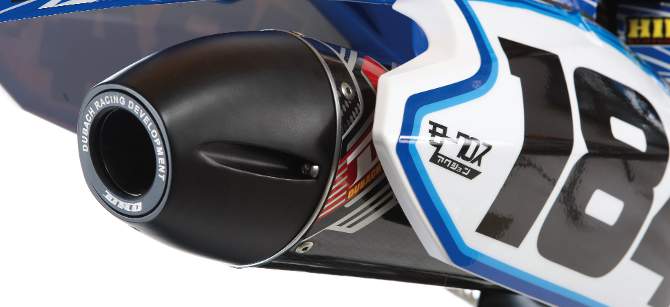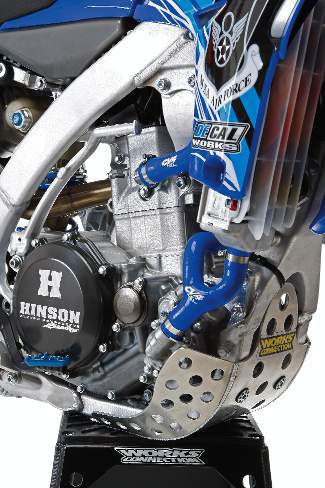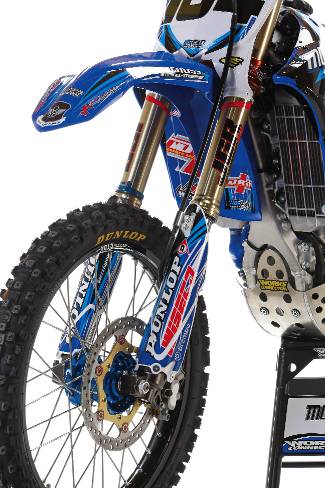INSIDE MXA’S WORKSHOP: BUILDING THE ULTIMATE 2012 YAMAHA YZ450F – THIS IS THE MOST RELIABLE MOTOCROSS BIKE MADE

By Dennis Stapleton
I spend most of my time switching bikes. When I’m testing I get to ride every new bike and when I’m racing, normally in some foreign country, I ride the bike the promoter provides me. I don’t spend a lot of time on one specific brand of bike. When I was newbie MXA test rider I always marveled at how the old-school MXA test riders could get off one bike and on another one, without as much as moving the bars or changing the levers. I, on the other hand, couldn’t ride if everything wasn’t in its perfect spot. Now, after my time at MXA, I can ride any brand, with any bar bend, and the levers pointed straight up or straight down. So, when MXA said that I could build whatever bike I wanted, spend as much money as necessary and use any part that was available. I was a happy camper, but…
I have a problem. I’m a bike breaker. In a strange way, this trait is beneficial as an MXA test rider, because we want to push bikes and products to their breaking points. But as a full-fledged AMA National privateer, I hate seeing money literally go up in smoke?especially when it is mine. There’s a joke among the MXA gang that if they need to find out if a product is durable, all they have to do is give it to me for a few hours. Rarely does something pass the “Stapleton test.”
Trust me, I don’t try to obliterate bikes. If I had my choice, I’d rather have a bike stay in optimal working condition, as opposed to giving the bike back to the manufacturer in a cardboard box. I don’t take pride in shelling engines, dropping transmissions, bending rims and exploding spokes. I ride hard, and I ride often. That’s the way it goes, and I’ve learned to accept the consequences of my actions.
And then the Yamaha YZ450F came along. Last year, I was given the opportunity to do a long-term test of the YZ450F. I think the MXA brain trust put me on the Yamaha because they were tired of me breaking bikes. They told me the YZ450F was bulletproof?by which they meant Stapleton-proof. After months of riding the bike, I only managed to crack the chain guide housing. That’s it! I had finally found a motorcycle that could keep up with my riding habits.

For as good as the 2012 Yamaha YZ450F is off idle, it’s lacking from the midrange and into the top end. A DR.D titanium exhaust is exactly what the doctor ordered (pun intended). Doug Dubach hooked us up with his titanium/carbon exhaust.
Having worked as an MXA test rider for seven years, I have built good relationships with Yamaha’s R&D team. Steve Butler, Doug Dubach, Tim Olson and Jonathan Belding are always willing to answer my questions and address my complaints. They know what I like in a motorcycle, and more important, they know what I don’t like. When it came time to select a bike to race for the 2012 season, I opted for the venerable YZ450F. Knowing how durable the Yamaha was, coupled with the blue crew’s commitment to helping me find peace with the YZ450F, was all I needed.
Step one: I’ve grown to appreciate Yamaha’s forward-thinking approach when they developed the original 2010 Yamaha YZ450F. In the years since the bike’s release, Yamaha has remained true to the downdraft-injection, centralization-of-mass principle and backwards-facing cylinder. Have these ideas changed the face of motocross? No. However, they did make waves and gave aftermarket companies something to think about.
In stock trim, the YZ450F has quirky handling traits. Then again, I much prefer the current frame to the pre-2010 YZ450F. On the old frame, I couldn’t get the front end to turn whatsoever. It drifted and lacked any sort of planted feel in corners. So, as odd as the new frame layout is, it’s an improvement over its predecessor.
I tend to steer with the throttle. This technique is great for going fast, but it doesn’t help on a light-steering bike. The 2012 YZ450F is the very definition of a light-steering bike. Desperate to get comfortable, I enlisted the services of Doug Dubach, Yamaha’s chief R&D test rider and the owner of DR.D, to help me find the sweet spot. Doug recommended his engine relocation kit ($149.95), which moves the engine forward 2.5mm (I actually used a prototype 3mm unit as part of the test procedure). This change in weight bias puts more load on the front end. Although engine relocation collars might seem like a new technique, Dubach has been moving the engine around on his bike since way back in the YZ426F days.

Made in England, the Raptor titanium footpegs are the choice of Ryan Dungey, KTM and Dennis Stapleton.
Naturally, Dubach also helped me install his DR.D radiator lowering kit, which drops the radiator 27mm on the bike. Dropping the radiators lowers the bike’s center of gravity, which improves cornering ability?something I desperately needed. The radiator lowering kit costs $99.95 and is worth every penny.
Step two: Doug Dubach massaged my YZ450F to the point of near-perfect cornering, but I couldn’t leave well enough alone. My brain was fixated on a trick set of Xtrig X-clamps. Not only do the clamps have adjustable offset, but they offer the patented PHDS (Progressive Handlebar Damping System). I’m not alone in saying that the YZ450F emits hand-numbing vibrations at the handlebars. Xtrig created a rubber mounting system that prevents vibrations from transferring through the bars. Eureka! The Xtrig X-clamp isn’t cheap?it’s $799.99?but it made perfect sense for my needs.
As far as the variable offset is concerned, I elected to choose between the standard 22mm offset and Xtrig’s 20mm option. Xtrig also sells a 23mm?25mm option, as well as a 12mm?14mm Supermoto clamp. By rotating the steering stem 180 degrees, I could choose between the two offsets. I preferred the 20mm offset on tighter tracks, but the front end knifed on faster tracks. Fortunately, it doesn’t take long at all to switch between the two different offsets.
Step three: I’ve liked the Joe Gibbs Racing guys ever since they let me sneak into their semi during the races and eat all of their cookies. Team owner Coy Gibbs has a penchant for junk food. I do, too. It was our shared love of sweets that brought us together, but it’s our common bond of working on the YZ450F that truly sparked the relationship.
 It’s what you don’t see that will surprise you. DR.D helped us install his engine relocation kit, which moves the engine 2.5mm forward and helps distribute more weight on the front end. We also sprang for a DR.D radiator lowering kit. |
 JGR isn’t merely a race team?they also do suspension and engine modifications.
|
Perhaps you didn’t realize that JGR offers suspension and engine modifications. Their staff of professionals are responsible for getting the bikes of Davi Millsaps and Kyle Regal (and not so much with James Stewart) dialed. These same guys will work on your engine or suspension. How cool is that? So one day, while Coy Gibbs and I were splitting a package of Pop Tarts, I asked if he would service the suspension on my MXA Workshop YZ450F. He kindly obliged.
I shipped my suspension to the JGR facility in North Carolina, where Jonny Oler went to work. He put the forks and shock on a dyno to accurately simulate and record information. Oler then adjusted the settings to specifically suit my needs, tested the suspension on the dyno and sent the units back to me. The whole process took less than two weeks. I owe those guys big time. Who knows, maybe I’ll learn how to bake the JGR team a tray of cookies as a gesture of thanks. Or, maybe I’ll just continue pillaging their semi.
Step four: There wasn’t any way that Doug Dubach was letting me leave his race shop without putting a DR.D exhaust system on my YZ450F. I didn’t complain, because Doug hooked me up with his trick titanium/carbon fiber system ($979.95), complete with resonance chamber. The system helps the power transition smoothly from the bottom end into the midrange, and then it kicks out the jams. It’s no secret that the YZ450F needs an added dose of power in the top end, and the DR.D exhaust helps considerably.
 There are several unique features on our YZ450F, but the Xtrig adjustable offset clamps are the crown jewel. |
Adding an extra tooth to the rear sprocket also spiced up the powerband. Renthal sent me a nice care package that included a 13/49 sprocket combination, as well as beefy Twinwall 996 bend handlebars and medium-compound, blue, half-waffle grips. I completed the ensemble with a DID chain. Besides the exhaust system, gearing the bike down was the only adjustment I made to the YZ450F powerband.
Step five: I’m sure that I could put a Yamaha YZ450F through a wood chipper and it would come out with nary a scratch. Simply put, the YZ450F is Bruce Willis in the movie Unbreakable. I should know; I’ve logged more hours on the bike than anyone, aside from Doug Dubach. However, there was one Yamaha part that failed. Read that again: one part failed. What was it? I cracked the chain guide housing against a rock.
Having said that, the YZ450F does have some other potential weak spots. For instance, when I’m in the heat of battle, I abuse the clutch worse than a sumo wrestler at an all-you-can-eat buffet. As a result, the clutch fades and burns up quickly. It’s a bad habit that I just can’t kick. To help the clutch survive my abuse issues, I ordered a complete Hinson clutch kit. Now, my clutch lasts significantly longer and provides consistent feel at the lever throughout an entire moto.
I’m not immune to the trinket train. I like cool things, even if they don’t make much sense. And so it was with the JGR ignition cover, which is made by Hinson. The cover is made out of billet aluminum and is stronger than stock, but I wanted it just for its looks. The ignition cover dresses up the engine, plain and simple.
Step six: I believe that I was a lab rat in a previous life, because I sure make a good guinea pig. Maybe it’s the excitement of being the first person to do something, or a general lack of concern for safety, but I enjoy throwing caution to the wind. When Jody was building the Glen Helen National track’s massive triple step-up jump, he needed someone to see if it was doable. I agreed to give it a shot, and before I knew it, I was staring down at Jody’s smirking face from 50 feet up. I survived, but my wheels didn’t?they wobbled like a walrus on a bender after that.
Since that day, my lack of aversion to jumping big gaps hasn’t waned, but I have gotten smarter. Need proof? I make sure that the rims, hubs and spokes on my bike are indestructible. My wheels of choice are from Dubya. I use Talon hubs and DID ST-X rims. There’s nothing worse than having your rim taco or hub explode when landing from a jump. With the Dubya wheelset, I’m taking out an insurance policy against such a catastrophe.
Step seven: In the past two years, I’ve raced Supercross, AMA Nationals, Endurocross, WORCS, GNCC and Arenacross. Because I compete in so many different disciplines, I need a motorcycle that can handle the rigors of racing through rocks, whoops, trees and sand. I won’t race an event without having the proper protection on my bike. Failing to finish a race is bad, but putting a hole in my engine is worse. Four-strokes are expensive to repair.
I opted for a Works Connection engine guard. It protects the cases and covers the water-pump impeller. I can attack a rock garden without having second thoughts. That’s peace of mind right there. Works Connection also hooked me up with a clutch perch and hour meter. I believe that an hour meter is one of the most overlooked tools on your bike. I say “overlooked” because people don’t seem to understand the value of having a diagnostic apparatus for setting a maintenance schedule. Sure, the YZ450F is durable, but any motorcycle will die a quick death if you don’t keep up on oil changes and engine maintenance.
Step eight: By this point, I had the suspension, engine and handling dialed in, but I was in need of a few key personal items. Don’t get me wrong; I’m not a snob when it comes to requiring certain products to ride up to my potential. However, I can benefit from a few random aftermarket items. For starters, an oversize front brake rotor is a must. The YZ450F has a weak front brake that doesn’t allow me to brake deep into corners. I put my trust in a Brembo oversize rotor, which works valiantly.
 The YZ450F is another member of the weak front brake club. Brembo took care of that issue with a 270mm rotor. |
I commend Yamaha for outfitting the YZ450F with titanium footpegs. It’s nice to see a manufacturer that’s conscientious about weight. Having said that, I still swapped the stockers for a mean-looking set of Raptor titanium footpegs ($200). Not only are they wider than normal, but the sharp teeth provide ultimate traction.
I slapped on a Guts seat cover to help keep my body in place under hard acceleration. I also opted for Cycra’s brand-new, two-piece radiator shrouds, which replace the three-piece stock design. The front Cycra number plate, which has built-in triple clamp guards, keeps my expensive Xtrig clamps looking trick. I used a DT-1 air filter, along with blue CV4 radiator hoses and a CV4 high-pressure radiator cap to prevent the coolant from boiling over. Hammerhead provided a beefy shifter, case guard and rear brake pedal. I used Dunlop sneakers (MX71 front and 120-width MX51 rear) and DeCal Works graphics to complete the ensemble.
Step nine: My objective in building my 2012 race bike in the MXA workshop was to create a Yamaha YZ450F that worked in virtually every facet of riding. And since I’m very demanding on equipment, I wanted to minimize any potential issues that might arise over the course of the year. I’m happy to state that I did a very good job, and I didn’t go financially overboard like some of my fellow MXA brethren. (I’m talking about you, John Basher.)
In terms of suspension, JGR did an excellent job addressing my needs. The Kayaba units worked well across a wide range of obstacles and conditions. Of course, I’ll need to make a few changes when I race Supercross, but I know that Coy Gibbs and crew will help me out. Why? There’s a bond between men, and their candy that cannot be broken. The only thing I’ve added since this project bike was finished was a Steahly 9-ounce flywheel weight?which I loved.
Of course, I’d still be chasing my tail if not for Doug Dubach’s help. Doug recommended the engine relocation kit, which improved the handling traits of the YZ450F considerably. His experience and professionalism made all the difference in the world. For that, I’m grateful.
If you are a bike breaker, the Yamaha YZ450F is the best bike. I know, because I’ve broken every other brand in every other way. With my YZ450F, I got exactly what I wanted?a competitive bike that will handle the rigors of racing and still be in one piece when the year is done.





Comments are closed.